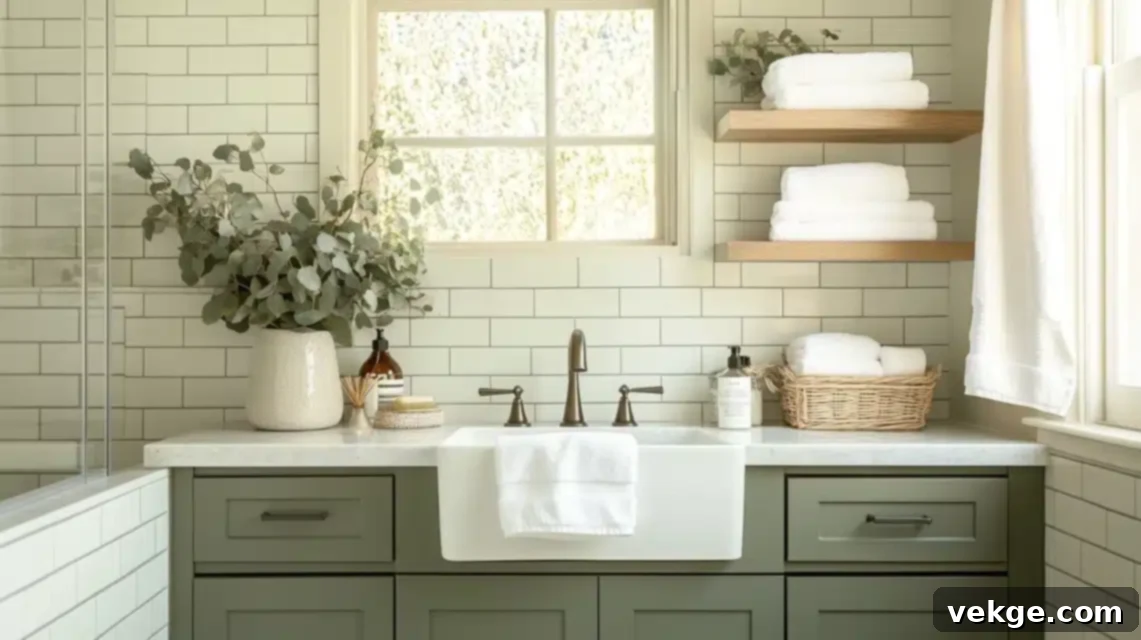Discover the Best Sherwin-Williams Sage Green Paint Colors for a Calming Home
Sage green has gracefully emerged as a quintessential color in modern home decor, captivating designers and homeowners alike with its unique blend of green and gray. This sophisticated hue offers a subtle yet profound connection to nature, bringing tranquility and balance to any space. What truly sets sage green apart is its remarkable versatility; it can lean warmer with hints of yellow or brown, or cooler with subtle blue undertones, allowing it to adapt seamlessly to diverse design aesthetics. Sherwin-Williams, a leader in paint innovation, offers an extensive palette of sage green shades, each with its own distinct personality. Whether you’re seeking a serene backdrop for your living room, a refreshing touch for your kitchen, or a welcoming exterior, there’s a Sherwin-Williams sage green waiting to transform your home. Let’s explore these captivating colors and unlock their potential.
The Enduring Appeal of Sage Green in Interior Design
The growing popularity of sage green isn’t just a fleeting trend; it’s a testament to its inherent qualities that resonate deeply with our desire for peace and natural beauty. This muted green-gray is far more than just a color; it’s a mood enhancer, a versatile companion, and a timeless statement. Its ability to create a calming and inviting atmosphere is unparalleled, making it a favored choice for those looking to infuse their homes with a sense of serenity and groundedness.
- A Haven of Calm: Sage green’s gentle, subdued tones are renowned for their psychological benefits, promoting relaxation, reducing stress, and fostering a sense of well-being. It creates an immediate feeling of ease, making any room a peaceful retreat from the outside world.
- Unmatched Versatility: From modern minimalist to rustic farmhouse, traditional elegance to bohemian chic, sage green effortlessly complements a vast array of design styles. Its neutral undertones allow it to pair beautifully with both warm and cool palettes, making it a truly adaptable choice for any homeowner.
- Timeless Elegance: Unlike bolder, more trendy colors that can quickly feel dated, sage green possesses a classic, enduring quality. Its connection to nature ensures it remains relevant and sophisticated, providing a long-lasting foundation for your home’s aesthetic that will stand the test of time.
- Bringing the Outdoors In: In an increasingly urbanized world, sage green offers a subtle way to reconnect with nature. It evokes images of lush landscapes and tranquil forests, creating an organic and refreshing ambiance indoors that enhances natural light and natural materials.
Discovering Sherwin-Williams Sage Green Paint Colors: A Curated Selection
Sherwin-Williams offers a magnificent collection of sage green shades, each with unique characteristics and undertones. To help you choose the perfect one, it’s essential to understand the Light Reflectance Value (LRV) of each color. LRV measures the percentage of light a paint color reflects, with 0 being absolute black and 100 being pure white. A higher LRV means the color will appear lighter and more open, while a lower LRV suggests a darker, more saturated look. Consider your room’s natural light and desired mood when reviewing these exquisite options.
| Paint Color | Description & Undertones | Light Reflectance Value (LRV) | Ideal Uses | Suggested Pairings |
|---|---|---|---|---|
| Clary Sage (SW 6178) | A beautifully balanced and warm sage, Clary Sage features subtle earthy yellow-brown undertones that give it a sophisticated, inviting presence. It’s incredibly versatile, adapting well to different lighting conditions. | 41 | Kitchen cabinets, cozy bathrooms, accent walls in living rooms, mudrooms, laundry rooms. | Soft off-whites (e.g., Sherwin-Williams Pure White), creamy beiges, natural wood tones (light oak), brushed gold or brass hardware, terracotta accents. |
| Oakmoss (SW 6180) | Oakmoss is a richer, darker sage with prominent yellow undertones, evoking a deep, organic, and grounded feeling. Its low LRV creates a sense of depth and luxury, especially in well-lit spaces. | 13 | Feature walls, formal dining rooms, studies, built-in bookshelves, mudrooms, exterior accents like shutters. | Satin brass fixtures, rich natural wood finishes (walnut, mahogany), crisp off-whites, charcoal grays, deep blues. |
| Ethereal Mood (SW 6181) | Living up to its name, Ethereal Mood is a soft, muted sage with gentle brown undertones that contribute to a serene, almost grayish appearance. It’s incredibly soothing and creates a tranquil atmosphere. | 38 | Bedrooms, guest rooms, interior doors, wainscoting, relaxed living areas, spa-like bathrooms. | Warm off-whites, creamy beiges, muted blues and greens, light natural wood (ash), aged brass or bronze. |
| Green Onyx (SW 9128) | Green Onyx presents a fresh, clean green-gray that’s brightened by a clear yellow undertone. It offers a soft, earthy, yet vibrant vibe, making it a beautiful choice for adding a touch of natural elegance. | 31 | Kitchen cabinets, bathroom vanities, children’s rooms, playrooms, small accent walls, entryways. | Satin gold and brass accents, natural woods (birch, maple), crisp white trim, light gray, soft peach or coral. |
| Swell Sage (SW 7742) | Swell Sage is an earthy green with pronounced yellow-brown undertones, giving it a subtle, muted, and slightly subdued character. It’s perfect for creating a cozy and grounded feel without being overpowering. | 41 | Accent walls, cozy reading nooks, powder rooms, home offices, smaller, more intimate spaces. | Soft whites, creamy beiges, warm browns, rich gold accents, natural fiber textures (jute, rattan). |
| Roycroft Bronze Green (SW 2846) | A dramatic and luxurious sage, Roycroft Bronze Green is a deep, moody shade with complex green, gray, yellow, and subtle bronze undertones. It’s part of Sherwin-Williams’ Arts and Crafts collection, offering a historical richness. | 9 | Bold statement walls, large living rooms, libraries, sophisticated bedrooms, historic homes, exterior trim. | White oak and walnut finishes, matte gold, satin chrome, deep leather, warm white for contrast. |
| Soften Green (SW 6177) | Soften Green is a light and airy sage that lives up to its name, providing a refreshing and gentle feel. Its delicate green-gray hue is incredibly subtle, perfect for spaces where you want just a whisper of color. | 49 | Kitchen cabinets, accent furniture, interior doors, nurseries, small bathrooms, ceilings for a soft touch. | Satin brass hardware, crisp white, light oak finishes, soft neutrals, pale pinks or blues. |
| Contended (SW 6172) | Contended is a beautiful cool sage with a noticeable blue undertone, offering a modern, serene, and almost ethereal aesthetic. It’s perfect for creating a clean, calming, and somewhat sophisticated atmosphere. | 52 | Smaller rooms, coastal or beach-themed spaces, bathrooms, bedrooms, minimalist interiors, children’s rooms. | Light blues, cool whites, various gray tones, light natural woods (birch, maple), chrome or brushed nickel. |
| Sage (SW 2860) | This aptly named color is a true, balanced sage, blending green, gray, and subtle yellow undertones for a classic, calming, and harmonious feel. It’s a foundational sage that works in nearly any setting. | 42 | Kitchen cabinets, bathroom vanities, accent walls, living rooms, bedrooms, main living areas. | Warm off-whites, a variety of wood finishes, muted grays, natural stone, black accents for contrast. |
| Escape Gray (SW 6186) | Escape Gray is a cool, gray-heavy sage with very subtle green undertones, offering a sophisticated, neutral, and incredibly calm appeal. It’s ideal for those who want a touch of green without overpowering a space. | 41 | Kitchen cabinets, bathroom vanities, accent walls in contemporary homes, offices, whole-house neutral. | Soft whites, light blues, natural textures like linen and cotton, chrome, light wood. |
| Secret Garden (SW 6181) | A dark, rich sage with pronounced olive undertones, Secret Garden provides a bold, luxurious, and deeply organic look. It creates a cocoon-like effect, perfect for intimate and dramatic spaces. | 8 | Built-in shelves, accent walls, powder rooms, media rooms, dramatic bedrooms, exterior siding. | White oak and dark walnut, brass accents, warm neutrals, earthy tones like terracotta and deep brown. |
| Eclipse (SW 6185) | Eclipse is a deep, dramatic sage with strong brown undertones, creating an incredibly cozy, serene, and enveloping atmosphere. Its low LRV makes it feel rich and sophisticated, especially in larger rooms. | 14 | Accent walls, cozy bedrooms, reading nooks, studies, living rooms with ample natural light, home theaters. | Light oak and white finishes for contrast, off-white, brass and gold accents, deep blues or burgundies. |
Why Sage Green is the Ultimate Choice for Your Home
Beyond its aesthetic appeal, sage green offers a multitude of practical and emotional benefits that make it an unparalleled choice for home decor. Its subtle nature ensures it never goes out of style, making it a smart investment for your home’s long-term beauty.
- Creates a Peaceful Sanctuary: The gentle tones of sage green have a profound calming effect, helping to reduce stress and promote relaxation. It transforms any room into a tranquil haven where you can unwind and feel at ease. This serene quality makes it ideal for bedrooms, bathrooms, and living spaces where comfort is paramount.
- Remarkable Versatility Across Rooms: Sage green is incredibly adaptable, performing beautifully in almost every area of your home. It can refresh kitchen cabinets with a modern farmhouse feel, create a spa-like ambiance in bathrooms, foster a restful environment in bedrooms, and add a touch of sophistication to living rooms. It’s even a fantastic choice for a welcoming front door or exterior siding.
- Complements Diverse Design Styles: Whether your home embraces minimalist modern lines, the rustic charm of a farmhouse, the eclectic vibe of bohemian, or the timeless elegance of traditional decor, sage green seamlessly integrates. It acts as a sophisticated neutral, enhancing other elements without competing for attention, and works equally well with clean, simple designs and more ornate, detailed styles.
- A Timeless and Enduring Trend: While many color trends come and go, sage green has solidified its place as a enduring classic. Its connection to nature gives it an inherent timelessness, ensuring your home’s aesthetic remains fresh and relevant for years to come. Choosing sage green means investing in a look that is both current and built to last.
How to Incorporate Sage Green into Different Spaces
Sage green’s chameleon-like ability allows it to shine in various applications throughout your home. Here are some specific ideas for integrating this beautiful hue into different rooms.
Kitchens: A Fresh and Inviting Culinary Space
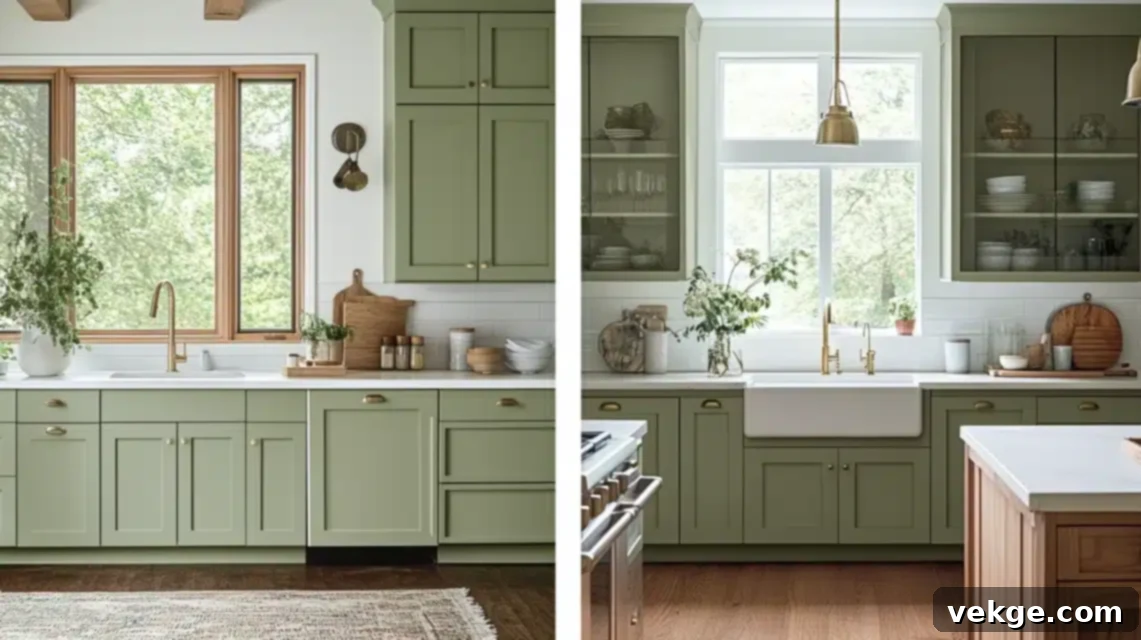
Transform your kitchen into a fresh and inviting space by painting your cabinets sage green. This color provides a sophisticated alternative to traditional white or gray, adding character and warmth. It looks particularly stunning on kitchen islands, creating a focal point, or can be used on a single accent wall to introduce subtle color. Many homeowners adore sage green in their kitchens because it pairs exquisitely with white countertops, butcher block surfaces, and various wood tones, creating a harmonious and organic feel. Consider pairing it with brass hardware for a touch of elegance or matte black for a modern edge.
Bathrooms: Your Personal Spa Retreat
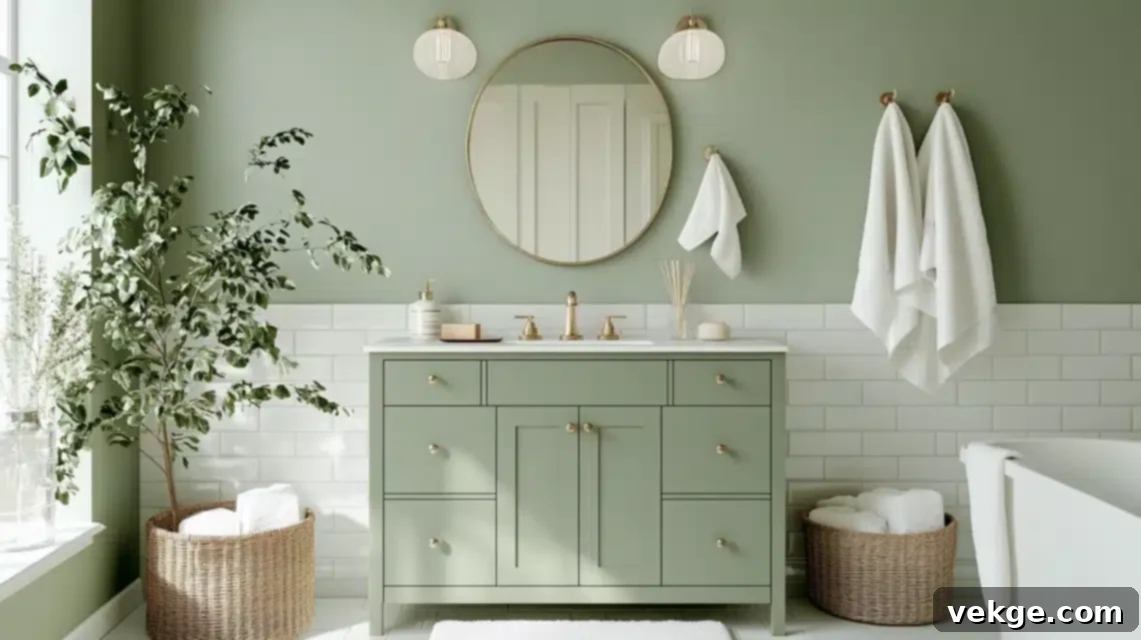
Infuse your bathroom with a serene, spa-like atmosphere by incorporating sage green. Painting the vanity in a beautiful sage shade can instantly elevate the space, making it feel more like a personal retreat. On bathroom walls, especially when combined with crisp white tiles or marble, sage green appears clean, fresh, and utterly calming. For a less permanent update, introduce small touches of sage green through plush hand towels, a textured bath mat, or a stylish shower curtain. These accents can refresh the space without the need for a full renovation.
Living Rooms: Cozy and Refined Gatherings
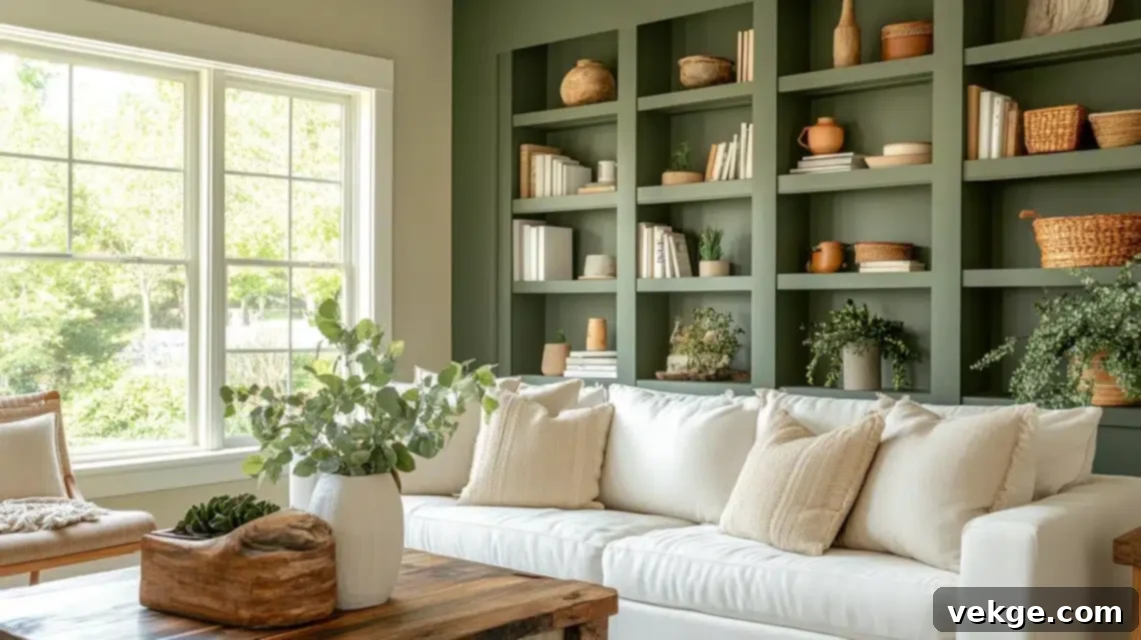
Create a focal point or a cozy backdrop in your living room by painting one wall in a welcoming sage green. This color works exceptionally well on built-in shelves or storage units, enhancing their architectural details and adding depth. For a more subtle integration of nature, incorporate sage green through decorative elements like throw pillows, soft blankets, or captivating artwork. Pair it with neutral sofas, natural wood furniture, and metallic accents for a balanced and inviting space perfect for relaxation and entertaining.
Bedrooms: A Haven for Restful Sleep
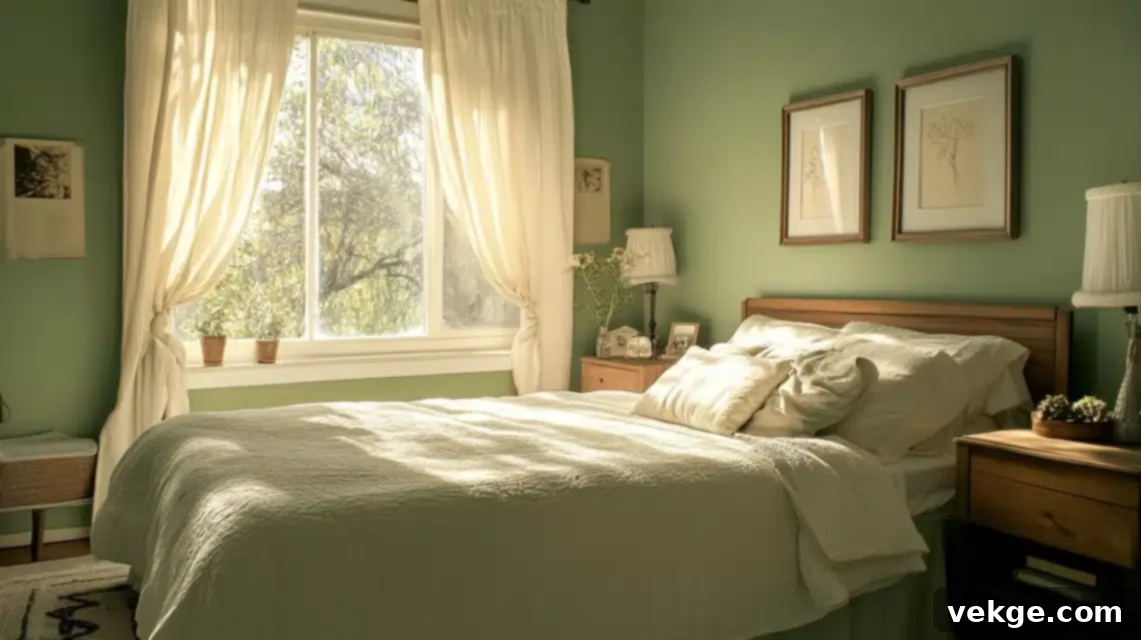
Transform your bedroom into the ultimate sanctuary for restful sleep with the gentle presence of sage green. Painting the walls in this soothing color creates an enveloping and tranquil environment, perfect for unwinding at the end of the day. Alternatively, integrate sage green through soft bedding, flowing curtains, or a cozy throw blanket. The natural softness and calming properties of sage green contribute to a quiet and peaceful atmosphere, helping you achieve better, more restorative sleep.
Exterior: A Welcoming and Harmonious Entrance
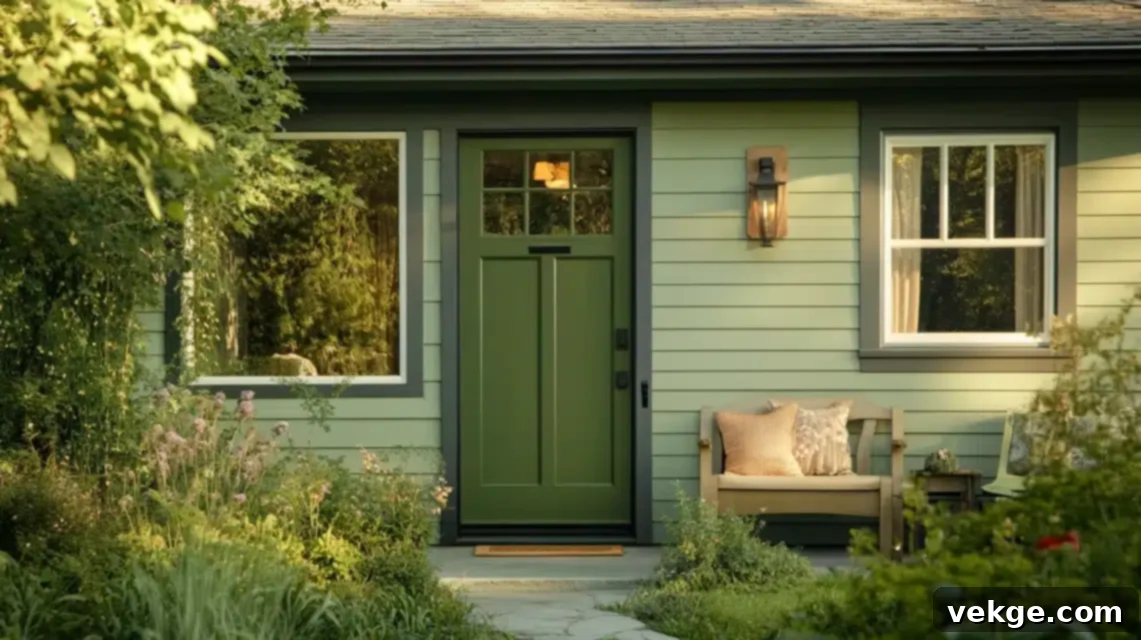
Extend the charm of sage green to your home’s exterior to create a welcoming and harmonious first impression. A sage green front door instantly adds curb appeal and a touch of classic elegance. The color also looks beautiful on window frames, shutters, or outdoor seating, providing a cohesive and natural aesthetic. Sage green blends effortlessly with most house colors—be it brick, stone, or siding—and seamlessly connects your home to its natural surroundings, enhancing its overall curb appeal with an organic touch.
Essential Tips for Choosing the Perfect Sage Green
Selecting the ideal sage green involves more than just liking a swatch. It requires careful consideration of your home’s unique characteristics and your personal style. Follow these expert tips to ensure you make the best choice for your space.
1. Understand Your Lighting: The Key to Color Perception
Lighting is arguably the most critical factor in how any paint color will appear in your space, and sage green is no exception. Natural light can dramatically alter its look: morning sunlight, often cooler and brighter, might highlight the green undertones, making it appear fresher. Afternoon light, typically warmer, can bring out more of the gray or brown nuances, giving it a cozier feel. Evening light, especially with artificial bulbs, can make sage green look darker, more muted, or even alter its undertones significantly. Always observe how the color changes throughout the day and under different artificial light sources. Spaces with less natural light may require a higher LRV sage green to prevent the room from feeling too dim.
2. Match Your Style: Harmonizing with Your Home’s Aesthetic
Your home’s existing design style should guide your sage green selection. Different shades complement various aesthetics:
- Modern or Contemporary Homes: Lean towards cleaner, cooler sage tones with subtle blue or gray undertones (like Contended or Escape Gray). These shades will complement sleek lines, minimalist decor, and materials like concrete or polished metal.
- Farmhouse or Rustic Spaces: Warmer sage greens with dominant yellow or brown undertones (such as Clary Sage or Swell Sage) will feel right at home. These pair beautifully with natural wood, distressed finishes, and cozy textures.
- Traditional or Classic Interiors: Balanced, true sage greens or those with a hint of antique bronze (like Sage or Roycroft Bronze Green) offer a sophisticated, timeless look. They work well with classic furniture, rich fabrics, and historical details.
- Bohemian or Eclectic Rooms: Both vibrant earthy sages and muted, organic shades can work. Consider how it will complement your existing patterns, global influences, and layered textures.
- Simple, Minimalist Rooms: These spaces can handle slightly bolder or more saturated sage greens if the rest of the decor is kept understated, allowing the color to make a quiet statement.
- Busy or Eclectic Rooms: Opt for softer, more subtle versions of sage to provide a calming backdrop without adding to the visual noise.
3. Test Before You Commit: The Power of Paint Samples
Never skip the crucial step of testing paint samples directly on your walls. Purchase large swatches or sample pots and paint them on different walls in the room you intend to transform. Observe these samples for several days under various conditions:
- In bright morning light.
- At high noon, when light is most intense.
- During the warmer hues of evening light.
- With all your artificial lights turned on, both day and night.
- Next to your existing furniture, flooring, and decor to ensure harmonious coordination.
This allows you to see how the color interacts with your specific environment, preventing costly mistakes and ensuring you’ll love the final result.
4. Start Small: Build Confidence with Sage Green Accents
If you’re hesitant about committing to sage green on a large scale, start by introducing it through smaller, more manageable elements. This approach allows you to gauge your comfort level and see how the color feels in your home without a full repaint:
- Add throw pillows, blankets, or rugs in varying sage green shades.
- Paint a small accent piece of furniture, like a side table, a bookshelf, or a picture frame.
- Try it on a single accent wall in a less prominent area, like a hallway or a powder room.
- Incorporate sage green into artwork, decorative vases, plant pots, or lampshades.
- Consider painting the inside of a bookcase or the back of a display cabinet for a subtle pop of color.
Pairing Sage Green with Other Colors and Materials
One of sage green’s greatest strengths is its ability to harmonize beautifully with a wide range of other colors and materials, making it incredibly easy to integrate into existing decor. To truly make your sage green shine, consider these thoughtful pairings:
- Neutrals:
- Whites and Creams: Crisp whites provide a clean, fresh contrast, while warmer off-whites and creams enhance sage green’s softness and warmth.
- Grays: Light, cool grays can create a sophisticated, contemporary feel, while warmer grays can add depth and coziness.
- Beiges and Tans: These earthy neutrals enhance sage green’s organic roots, creating a soft, natural, and inviting palette.
- Wood Tones:
- Light Woods: Light oak, birch, and maple create a bright, airy, and modern aesthetic.
- Dark Woods: Walnut, cherry, and mahogany add a touch of drama, richness, and traditional elegance.
- Reclaimed Woods: Bring out the rustic and natural charm of sage green, perfect for farmhouse or bohemian styles.
- Metals:
- Brass and Gold: These warm metals beautifully complement sage green, adding a touch of luxury and sophistication, especially with warmer sage tones.
- Matte Black: Creates a striking, modern contrast that feels bold and grounded.
- Brushed Nickel/Chrome: Offers a cooler, more contemporary pairing that works well with bluer or grayer sage greens.
- Textiles and Textures:
- Linen and Cotton: Emphasize sage green’s natural and organic feel, perfect for a relaxed, comfortable atmosphere.
- Wool and Velvet: Add warmth, depth, and luxurious texture, enhancing the cozy appeal of deeper sage shades.
- Rattan and Jute: Introduce natural, earthy textures that reinforce the connection to the outdoors.
- Accent Colors:
- Muted Blues: Create a calm, coastal, or ethereal palette.
- Soft Pinks and Terracotta: Introduce warmth and a delicate, earthy contrast.
- Deep Greens and Olives: Layering different shades of green can create a rich, monochromatic, and deeply calming effect.
Conclusion: Embrace the Serenity of Sage Green
Sage green is more than just a paint color; it’s an invitation to bring peace, nature, and timeless elegance into your home. Sherwin-Williams offers a remarkable array of sage green shades, from the earthy warmth of Clary Sage to the dramatic depth of Eclipse, ensuring there’s a perfect hue for every space and every style. Whether you envision it gracing your kitchen cabinets, creating a spa-like bathroom, or setting a serene tone in your living room, sage green promises to transform your environment.
By carefully considering your lighting, matching the color to your home’s aesthetic, and utilizing the power of paint samples, you can confidently choose the ideal shade. Paired with soft whites, rich natural woods, and elegant brass accents, sage green’s enduring versatility and calming influence make it a smart and beautiful choice for any long-term home design project. Embrace the tranquility and sophisticated charm that only sage green can provide, and watch your home flourish into a true sanctuary.
Frequently Asked Questions
Can sage green be used in modern interior design?
Absolutely! Sage green is incredibly versatile and works exceptionally well in modern spaces. To achieve a contemporary look, pair cooler sage tones with clean lines, minimal decor, sleek furniture, and modern materials like polished concrete, black metal, or white quartz countertops. Its understated nature provides a sophisticated and refreshing backdrop for modern aesthetics.
Where can I purchase Sherwin Williams sage green paint samples?
You can easily purchase Sherwin-Williams sage green paint samples directly from any Sherwin-Williams store location. Additionally, you can order both small peel-and-stick paint swatches (which are excellent for testing without commitment) and small liquid sample containers online through the official Sherwin-Williams website. Online ordering allows you to have samples delivered directly to your home for convenient testing.
What finish is best for sage green paint in different rooms?
The best paint finish depends on the room’s function and the desired durability and appearance:
- Walls (Living Rooms, Bedrooms, Dining Rooms): Eggshell or Satin finish is generally recommended. Eggshell offers a subtle sheen and is more durable than flat, while satin provides a slightly higher luster and is easier to clean.
- Trim, Doors, and Ceilings: Semi-gloss or High-gloss is ideal for trim and doors as it provides a durable, easy-to-clean surface that highlights architectural details. For ceilings, a flat finish is often preferred to minimize imperfections and absorb light.
- Kitchen Cabinets and High-Moisture Areas (Bathrooms): Pearl or Semi-gloss finishes are excellent choices for cabinets and areas prone to moisture. These finishes are highly durable, resistant to scrubbing, and stand up well to humidity and daily wear and tear.
Is sage green a warm or cool color?
Sage green is unique because it can lean either warm or cool, depending on its undertones. If it has more yellow or brown undertones (like Clary Sage or Oakmoss), it will appear warmer and more earthy. If it has more blue or gray undertones (like Contended or Escape Gray), it will appear cooler and more muted. This versatility allows you to choose a sage green that perfectly complements the existing warm or cool elements in your space.
What other colors pair well with sage green?
Sage green is a fantastic partner for a wide array of colors. It pairs beautifully with classic neutrals like crisp whites, creamy off-whites, warm beiges, and various shades of gray (both warm and cool). For accent colors, consider muted blues (like dusty blue or periwinkle), soft pinks, terracotta, deep rust, and even other shades of green for a harmonious monochromatic palette. Its natural appeal also makes it an excellent match for natural wood tones, brass, gold, and matte black metals.
